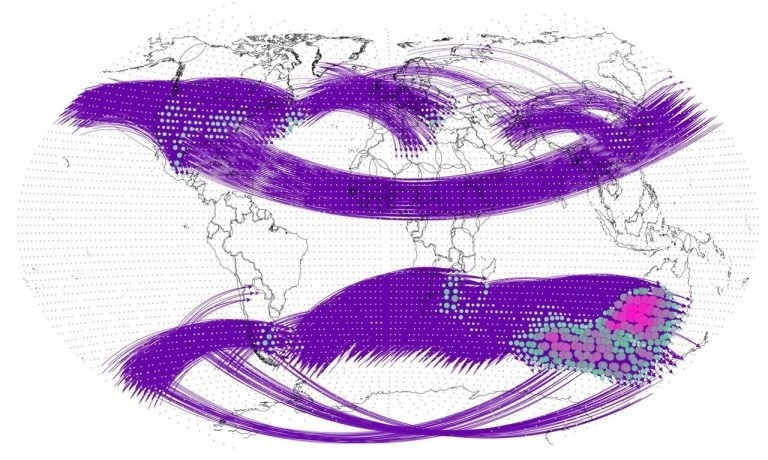The increasing frequency of extreme weather events worldwide, such as wildfires and floods, due to climate change underscores the fact that these events are not random but interconnected.
 The structure of teleconnections as depicted within the climate network. Image Credit: Shang Wang, Jun Meng, and Jingfang Fan
The structure of teleconnections as depicted within the climate network. Image Credit: Shang Wang, Jun Meng, and Jingfang Fan
The study of these linked climate phenomena, known as teleconnections, remains a relatively uncharted territory, yet it is essential for gaining a comprehensive understanding of our climate system.
In the journal "Chaos," published by AIP Publishing, a group of researchers associated with Beijing Normal University and the Potsdam Institute for Climate Impact Research in Germany, in collaboration with Beijing University of Posts and Telecommunications in China, introduces a climate network analysis approach for investigating the strength, geographical patterns, and changes in teleconnections.
Teleconnections describe how climate events in one part of the world can affect weather thousands of kilometers away. Think of it as a domino effect on a global scale.
Jingfang Fan, Study Co-Author, Beijing Normal University
Jingfang Fan, Co-Author of the Study and affiliated with Beijing Normal University and the Potsdam Institute for Climate Impact Research, emphasizes that "within just five years, we may see temperatures rising to levels that global scientists have been warning us about. It's like the planet is running a fever that's steadily getting worse."
Climate networks can be likened to maps, with data points representing specific locations and the links between these points revealing similarities.
The climate network analysis method developed by the researchers combines the directions and distribution patterns of teleconnections to assess their strength and pinpoint areas that are particularly susceptible. This analysis relies on sophisticated data processing techniques and mathematical algorithms to extract critical information about climate teleconnections.
Our work uncovered patterns in climate events driven mainly by atmospheric Rossby waves, which are large inertial planetary waves that naturally occur in rotating fluids and cause movement within the atmosphere.
Jingfang Fan, Study Co-Author, Beijing Normal University
The research team pinpointed regions notably impacted by these interrelated events, with a specific focus on areas like southeastern Australia and South Africa, which were found to be particularly sensitive.
A captivating revelation from their study is that these connections have been strengthening over time, from 1948 to 2021, possibly influenced by a combination of factors, including climate change, human activities, and other variables. Notably, the extent and intensity of these teleconnection impacts have become more pronounced in the Southern Hemisphere over the past 37 years.
This research offers a novel approach to assessing and analyzing climate teleconnections. The researchers intend to apply this newfound knowledge to identify regions that may face heightened risks in the future and to develop strategies for addressing these emerging challenges.
The next step is like weather forecasting—but on steroids. Using what we’ve learned, we plan to predict how climate events will unfold and connect. We’re diving deep to explore why these events happen and how various climate ‘tipping points’ within our climate system might be linked.
Jingfang Fan, Study Co-Author, Beijing Normal University
Journal Reference:
Wang, S., et al. (2023). Exploring the intensity, distribution and evolution of teleconnections using climate network analysis. Chaos: An Interdisciplinary Journal of Nonlinear Science. doi.org/10.1063/5.0153677.